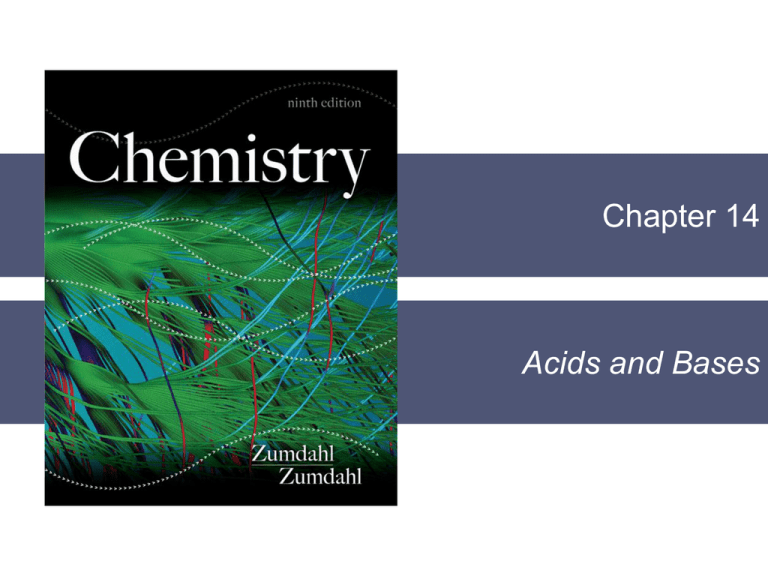
Chapter 14
Acids and Bases
Section 14.1
The Nature of Acids and Bases
Models of Acids and Bases
Arrhenius: Acids produce H+ ions in solution, bases
produce OH- ions.
Brønsted–Lowry: Acids are proton (H+) donors,
bases are proton acceptors.
HCl + H2O
Cl- + H3O+
acid base
Copyright © Cengage Learning. All rights reserved
2
Section 14.1
The Nature of Acids and Bases
Brønsted–Lowry Reaction
To play movie you must be in Slide Show Mode
PC Users: Please wait for content to load, then click to play
Mac Users: CLICK HERE
Copyright © Cengage Learning. All rights reserved
3
Section 14.1
The Nature of Acids and Bases
Acid in Water
HA(aq)
+
H2O(l)
H3O+(aq) +
A-(aq)
Conjugate base is everything that remains of the acid
molecule after a proton is lost.
Conjugate acid is formed when the proton is
transferred to the base.
Copyright © Cengage Learning. All rights reserved
4
Section 14.1
The Nature of Acids and Bases
Acid Ionization Equilibrium
To play movie you must be in Slide Show Mode
PC Users: Please wait for content to load, then click to play
Mac Users: CLICK HERE
Copyright © Cengage Learning. All rights reserved
5
Section 14.2
Acid Strength
Strong acid:
Ionization equilibrium lies far to the right.
Yields a weak conjugate base.
Weak acid:
Ionization equilibrium lies far to the left.
Weaker the acid, stronger its conjugate base.
Copyright © Cengage Learning. All rights reserved
6
Section 14.2
Acid Strength
Copyright © Cengage Learning. All rights reserved
7
Section 14.2
Acid Strength
Various Ways to Describe Acid Strength
Copyright © Cengage Learning. All rights reserved
8
Section 14.2
Acid Strength
Water as an Acid and a Base
Water is amphoteric:
Behaves either as an acid or as a base.
At 25°C:
Kw = [H+][OH–] = 1.0 × 10–14
No matter what the solution contains, the product of
[H+] and [OH–] must always equal 1.0 × 10–14 at
25°C.
Copyright © Cengage Learning. All rights reserved
9
Section 14.2
Acid Strength
Three Possible Situations
[H+] = [OH–]; neutral solution
[H+] > [OH–]; acidic solution
[OH–] > [H+]; basic solution
Copyright © Cengage Learning. All rights reserved
10
Section 14.2
Acid Strength
Self-Ionization of Water
To play movie you must be in Slide Show Mode
PC Users: Please wait for content to load, then click to play
Mac Users: CLICK HERE
Copyright © Cengage Learning. All rights reserved
11
Section 14.2
Acid Strength
CONCEPT CHECK!
HA(aq) + H2O(l)
acid
base
H3O+(aq) + A-(aq)
conjugate conjugate
acid
base
What is the equilibrium constant expression for
an acid acting in water?
H3O A
K =
HA
Copyright © Cengage Learning. All rights reserved
12
Section 14.2
Acid Strength
CONCEPT CHECK!
If the equilibrium lies to the right, the value for Ka
is __________.
large (or >1)
If the equilibrium lies to the left, the value for Ka is
___________.
small (or <1)
Copyright © Cengage Learning. All rights reserved
13
Section 14.2
Acid Strength
CONCEPT CHECK!
HA(aq) + H2O(l)
H3O+(aq) + A–(aq)
If water is a better base than A–, do products
or reactants dominate at equilibrium?
Does this mean HA is a strong or weak acid?
Is the value for Ka greater or less than 1?
Copyright © Cengage Learning. All rights reserved
14
Section 14.2
Acid Strength
CONCEPT CHECK!
Consider a 1.0 M solution of HCl.
Order the following from strongest to weakest base and
explain:
H2O(l)
A–(aq) (from weak acid HA)
Cl–(aq)
Copyright © Cengage Learning. All rights reserved
15
Section 14.2
Acid Strength
Let’s Think About It…
How good is Cl–(aq) as a base?
Is A–(aq) a good base?
The bases from strongest to weakest are:
A–, H2O, Cl–
Copyright © Cengage Learning. All rights reserved
16
Section 14.2
Acid Strength
CONCEPT CHECK!
Consider a solution of NaA where A– is the anion from
weak acid HA:
A–(aq) + H2O(l)
base
acid
HA(aq) + OH–(aq)
conjugate conjugate
acid
base
a) Which way will equilibrium lie?
left
Copyright © Cengage Learning. All rights reserved
17
Section 14.2
Acid Strength
CONCEPT CHECK!
Consider a solution of NaA where A– is the anion from
weak acid HA:
A–(aq) + H2O(l)
base
acid
HA(aq) + OH–(aq)
conjugate conjugate
acid
base
b) Is the value for Kb greater than or less than 1?
less than 1
Copyright © Cengage Learning. All rights reserved
18
Section 14.2
Acid Strength
CONCEPT CHECK!
Consider a solution of NaA where A– is the anion from
weak acid HA:
A–(aq) + H2O(l)
base
acid
HA(aq) + OH–(aq)
conjugate conjugate
acid
base
c) Does this mean A– is a strong or weak base?
weak base
Copyright © Cengage Learning. All rights reserved
19
Section 14.2
Acid Strength
CONCEPT CHECK!
Acetic acid (HC2H3O2) and HCN are both weak acids.
Acetic acid is a stronger acid than HCN.
Arrange these bases from weakest to strongest and
explain your answer:
H2O
Copyright © Cengage Learning. All rights reserved
Cl–
CN–
C2H3O2–
20
Section 14.2
Acid Strength
Let’s Think About It…
H2O(l) + H2O(l)
acid base
H3O+(aq) + OH–(aq)
conjugate conjugate
acid
base
At 25°C, Kw = 1.0 × 10–14
The bases from weakest to strongest are:
Cl–, H2O, C2H3O2–, CN–
Copyright © Cengage Learning. All rights reserved
21
Section 14.2
Acid Strength
CONCEPT CHECK!
Discuss whether the value of K for the reaction:
HCN(aq) + F–(aq)
CN–(aq) + HF(aq)
is >1
<1
=1
(Ka for HCN is 6.2×10–10; Ka for HF is 7.2×10–4.)
Explain your answer.
Copyright © Cengage Learning. All rights reserved
22
Section 14.2
Acid Strength
CONCEPT CHECK!
Calculate the value for K for the reaction:
HCN(aq) + F–(aq)
CN–(aq) + HF(aq)
(Ka for HCN is 6.2×10–10; Ka for HF is 7.2×10–4.)
K = 8.6 × 10–7
Copyright © Cengage Learning. All rights reserved
23
Section 14.3
The pH Scale
pH = –log[H+]
pH changes by 1 for every power of 10 change in [H+].
A compact way to represent solution acidity.
pH decreases as [H+] increases.
Significant figures:
The number of decimal places in the log is equal to
the number of significant figures in the original
number.
Copyright © Cengage Learning. All rights reserved
24
Section 14.3
The pH Scale
pH Range
pH = 7; neutral
pH > 7; basic
Higher the pH, more basic.
pH < 7; acidic
Lower the pH, more acidic.
Copyright © Cengage Learning. All rights reserved
25
Section 14.3
The pH Scale
The pH Scale and pH
Values of Some Common
Substances
Copyright © Cengage Learning. All rights reserved
26
Section 14.3
The pH Scale
EXERCISE!
Calculate the pH for each of the following solutions.
a) 1.0 × 10–4 M H+
pH = 4.00
b) 0.040 M OH–
pH = 12.60
Copyright © Cengage Learning. All rights reserved
27
Section 14.3
The pH Scale
EXERCISE!
The pH of a solution is 5.85. What is the [H+] for this
solution?
[H+] = 1.4 × 10–6 M
Copyright © Cengage Learning. All rights reserved
28
Section 14.3
The pH Scale
pH and pOH
Recall:
Kw = [H+][OH–]
–log Kw = –log[H+] – log[OH–]
pKw = pH + pOH
14.00 = pH + pOH
Copyright © Cengage Learning. All rights reserved
29
Section 14.3
The pH Scale
EXERCISE!
Calculate the pOH for each of the following solutions.
a) 1.0 × 10–4 M H+
pOH = 10.00
b) 0.040 M OH–
pOH = 1.40
Copyright © Cengage Learning. All rights reserved
30
Section 14.3
The pH Scale
EXERCISE!
The pH of a solution is 5.85. What is the [OH–] for this
solution?
[OH–] = 7.1 × 10–9 M
Copyright © Cengage Learning. All rights reserved
31
Section 14.4
Calculating the pH of Strong Acid Solutions
Thinking About Acid–Base Problems
What are the major species in solution?
What is the dominant reaction that will take place?
Is it an equilibrium reaction or a reaction that will go
essentially to completion?
React all major species until you are left with an
equilibrium reaction.
Solve for the pH if needed.
Copyright © Cengage Learning. All rights reserved
32
Section 14.4
Calculating the pH of Strong Acid Solutions
CONCEPT CHECK!
Consider an aqueous solution of 2.0 × 10–3 M HCl.
What are the major species in solution?
H+, Cl–, H2O
What is the pH?
pH = 2.70
Copyright © Cengage Learning. All rights reserved
33
Section 14.4
Calculating the pH of Strong Acid Solutions
CONCEPT CHECK!
Calculate the pH of a 1.5 × 10–11 M solution of HCl.
pH = 7.00
Copyright © Cengage Learning. All rights reserved
34
Section 14.4
Calculating the pH of Strong Acid Solutions
CONCEPT CHECK!
Calculate the pH of a 1.5 × 10–2 M solution of
HNO3.
Copyright © Cengage Learning. All rights reserved
35
Section 14.4
Calculating the pH of Strong Acid Solutions
Let’s Think About It…
When HNO3 is added to water, a reaction takes place
immediately:
HNO3 + H2O H3O+ + NO3–
Copyright © Cengage Learning. All rights reserved
36
Section 14.4
Calculating the pH of Strong Acid Solutions
Let’s Think About It…
Why is this reaction not likely?
NO3–(aq) + H2O(l)
Copyright © Cengage Learning. All rights reserved
HNO3(aq) + OH–(aq)
37
Section 14.4
Calculating the pH of Strong Acid Solutions
Let’s Think About It…
What reaction controls the pH?
H2O(l) + H2O(l)
H3O+(aq) + OH–(aq)
In aqueous solutions, this reaction is always taking
place.
But is water the major contributor of H+ (H3O+)?
pH = 1.82
Copyright © Cengage Learning. All rights reserved
38
Section 14.5
Calculating the pH of Weak Acid Solutions
Solving Weak Acid Equilibrium Problems
1. List the major species in the solution.
2. Choose the species that can produce H+, and write
balanced equations for the reactions producing H+.
3. Using the values of the equilibrium constants for the
reactions you have written, decide which equilibrium
will dominate in producing H+.
4. Write the equilibrium expression for the dominant
equilibrium.
Copyright © Cengage Learning. All rights reserved
39
Section 14.5
Calculating the pH of Weak Acid Solutions
Solving Weak Acid Equilibrium Problems
5. List the initial concentrations of the species participating
in the dominant equilibrium.
6. Define the change needed to achieve equilibrium; that
is, define x.
7. Write the equilibrium concentrations in terms of x.
8. Substitute the equilibrium concentrations into the
equilibrium expression.
Copyright © Cengage Learning. All rights reserved
40
Section 14.5
Calculating the pH of Weak Acid Solutions
Solving Weak Acid Equilibrium Problems
9. Solve for x the “easy” way, that is, by assuming that
[HA]0 – x about equals [HA]0.
10.Use the 5% rule to verify whether the approximation is
valid.
11.Calculate [H+] and pH.
Copyright © Cengage Learning. All rights reserved
41
Section 14.5
Calculating the pH of Weak Acid Solutions
CONCEPT CHECK!
Consider a 0.80 M aqueous solution of the weak acid
HCN (Ka = 6.2 × 10–10).
What are the major species in solution?
HCN, H2O
Copyright © Cengage Learning. All rights reserved
42
Section 14.5
Calculating the pH of Weak Acid Solutions
Let’s Think About It…
Why aren’t H+ or CN– major species?
Copyright © Cengage Learning. All rights reserved
43
Section 14.5
Calculating the pH of Weak Acid Solutions
Consider This
HCN(aq) + H2O(l)
H3O+(aq) + CN–(aq)
Ka = 6.2 × 10-10
H2O(l) + H2O(l)
H3O+(aq) + OH–(aq)
Kw = 1.0 × 10-14
Which reaction controls the pH? Explain.
Copyright © Cengage Learning. All rights reserved
44
Section 14.5
Calculating the pH of Weak Acid Solutions
EXERCISE!
Calculate the pH of a 0.50 M aqueous solution of the
weak acid HF.
(Ka = 7.2 × 10–4)
Copyright © Cengage Learning. All rights reserved
45
Section 14.5
Calculating the pH of Weak Acid Solutions
Let’s Think About It…
What are the major species in solution?
HF, H2O
Why aren’t H+ and F– major species?
Copyright © Cengage Learning. All rights reserved
46
Section 14.5
Calculating the pH of Weak Acid Solutions
Let’s Think About It…
What are the possibilities for the dominant reaction?
HF(aq) + H2O(l)
H3O+(aq) + F–(aq)
Ka=7.2 × 10-4
H2O(l) + H2O(l)
H3O+(aq) + OH–(aq)
Kw=1.0 × 10-14
Which reaction controls the pH? Why?
Copyright © Cengage Learning. All rights reserved
47
Section 14.5
Calculating the pH of Weak Acid Solutions
Steps Toward Solving for pH
H3O+(aq) +
F–(aq)
0.50 M
~0
~0
–x
+x
+x
0.50–x
x
x
HF(aq) + H2O
Initial
Change
Equilibrium
Ka = 7.2 × 10–4
pH = 1.72
Copyright © Cengage Learning. All rights reserved
48
Section 14.5
Calculating the pH of Weak Acid Solutions
Percent Dissociation (Ionization)
Percent dissociation =
amount dissociated (mol/L)
100%
initial concentration (mol/L)
For a given weak acid, the percent dissociation increases as the
acid becomes more dilute.
Copyright © Cengage Learning. All rights reserved
49
Section 14.5
Calculating the pH of Weak Acid Solutions
EXERCISE!
A solution of 8.00 M formic acid (HCHO2) is 0.47%
ionized in water.
Calculate the Ka value for formic acid.
Ka = 1.8 × 10–4
Copyright © Cengage Learning. All rights reserved
50
Section 14.5
Calculating the pH of Weak Acid Solutions
EXERCISE!
Calculate the pH of an 8.00 M solution of formic acid.
Use the data from the previous slide to help you solve
this problem.
pH = 1.42
Copyright © Cengage Learning. All rights reserved
51
Section 14.5
Calculating the pH of Weak Acid Solutions
EXERCISE!
The value of Ka for a 4.00 M formic acid solution should
be:
higher than
lower than
the same as
the value of Ka of an 8.00 M formic acid solution.
Explain.
Copyright © Cengage Learning. All rights reserved
52
Section 14.5
Calculating the pH of Weak Acid Solutions
CONCEPT CHECK!
The percent ionization of a 4.00 M formic acid solution
should be:
higher than
lower than
the same as
the percent ionization of an 8.00 M formic acid solution.
Explain.
Copyright © Cengage Learning. All rights reserved
53
Section 14.5
Calculating the pH of Weak Acid Solutions
CONCEPT CHECK!
The pH of a 4.00 M formic acid solution should be:
higher than
lower than
the same as
the pH of an 8.00 M formic acid solution.
Explain.
Copyright © Cengage Learning. All rights reserved
54
Section 14.5
Calculating the pH of Weak Acid Solutions
EXERCISE!
Calculate the percent ionization of a 4.00 M formic
acid solution in water.
% Ionization = 0.67%
Copyright © Cengage Learning. All rights reserved
55
Section 14.5
Calculating the pH of Weak Acid Solutions
EXERCISE!
Calculate the pH of a 4.00 M solution of formic acid.
pH = 1.57
Copyright © Cengage Learning. All rights reserved
56
Section 14.6
Bases
Arrhenius: bases produce OH– ions.
Brønsted–Lowry: bases are proton acceptors.
In a basic solution at 25°C, pH > 7.
Ionic compounds containing OH- are generally
considered strong bases.
LiOH, NaOH, KOH, Ca(OH)2
pOH = –log[OH–]
pH = 14.00 – pOH
Copyright © Cengage Learning. All rights reserved
57
Section 14.6
Bases
CONCEPT CHECK!
Calculate the pH of a 1.0 × 10–3 M solution of sodium
hydroxide.
pH = 11.00
Copyright © Cengage Learning. All rights reserved
58
Section 14.6
Bases
CONCEPT CHECK!
Calculate the pH of a 1.0 × 10–3 M solution of calcium
hydroxide.
pH = 11.30
Copyright © Cengage Learning. All rights reserved
59
Section 14.6
Bases
Equilibrium expression for weak bases uses Kb.
CN–(aq) + H2O(l)
Kb =
Copyright © Cengage Learning. All rights reserved
HCN(aq) + OH–(aq)
HCN
OH
CN
60
Section 14.6
Bases
pH calculations for solutions of weak bases are very
similar to those for weak acids.
Kw = [H+][OH–] = 1.0 × 10–14
pOH = –log[OH–]
pH = 14.00 – pOH
Copyright © Cengage Learning. All rights reserved
61
Section 14.6
Bases
CONCEPT CHECK!
Calculate the pH of a 2.0 M solution of ammonia (NH3).
(Kb = 1.8 × 10–5)
pH = 11.78
Copyright © Cengage Learning. All rights reserved
62
Section 14.7
Polyprotic Acids
Acids that can furnish more than one proton.
Always dissociates in a stepwise manner, one proton at
a time.
The conjugate base of the first dissociation equilibrium
becomes the acid in the second step.
For a typical weak polyprotic acid:
Ka1 > Ka2 > Ka3
For a typical polyprotic acid in water, only the first
dissociation step is important to pH.
Copyright © Cengage Learning. All rights reserved
63
Section 14.7
Polyprotic Acids
EXERCISE!
Calculate the pH of a 1.00 M solution of H3PO4.
Ka1 = 7.5 × 10-3
Ka2 = 6.2 × 10-8
Ka3 = 4.8 × 10-13
pH = 1.08
Copyright © Cengage Learning. All rights reserved
64
Section 14.7
Polyprotic Acids
CONCEPT CHECK!
Calculate the equilibrium concentration of PO43- in a
1.00 M solution of H3PO4.
Ka1 = 7.5 × 10-3
Ka2 = 6.2 × 10-8
Ka3 = 4.8 × 10-13
[PO43-] = 3.6 × 10-19 M
Copyright © Cengage Learning. All rights reserved
65
Section 14.8
Acid-Base Properties of Salts
Salts
Ionic compounds.
When dissolved in water, break up into its ions (which
can behave as acids or bases).
Copyright © Cengage Learning. All rights reserved
66
Section 14.8
Acid-Base Properties of Salts
Salts
The salt of a strong acid and a strong base gives a
neutral solution.
KCl, NaNO3
Copyright © Cengage Learning. All rights reserved
67
Section 14.8
Acid-Base Properties of Salts
Salts
A basic solution is formed if the anion of the salt is the
conjugate base of a weak acid.
NaF, KC2H3O2
Kw = Ka × Kb
Use Kb when starting with base.
Copyright © Cengage Learning. All rights reserved
68
Section 14.8
Acid-Base Properties of Salts
Salts
An acidic solution is formed if the cation of the salt is the
conjugate acid of a weak base.
NH4Cl
Kw = Ka × Kb
Use Ka when starting with acid.
Copyright © Cengage Learning. All rights reserved
69
Section 14.8
Acid-Base Properties of Salts
Cation
neutral
neutral
Anion
neutral
conjugate
base of
weak acid
neutral
Acidic
or Basic
neutral
basic
conjugate
acidic
acid of
weak base
conjugate conjugate depends
acid of
base of
on Ka & Kb
weak base weak acid
values
Copyright © Cengage Learning. All rights reserved
Example
NaCl
NaF
NH4Cl
Al2(SO4)3
70
Section 14.8
Acid-Base Properties of Salts
Qualitative Prediction of pH of Salt Solutions (from Weak
Parents)
Copyright © Cengage Learning. All rights reserved
71
Section 14.8
Acid-Base Properties of Salts
EXERCISE!
Ka = 1.8 × 10-5
Ka = 6.2 × 10-10
HC2H3O2
HCN
Calculate the Kb values for: C2H3O2− and CN−
Kb (C2H3O2-) = 5.6 × 10-10
Kb (CN-) = 1.6 × 10-5
Copyright © Cengage Learning. All rights reserved
Section 14.8
Acid-Base Properties of Salts
CONCEPT CHECK!
Arrange the following 1.0 M solutions from lowest to highest pH.
HBr
NaCN
NaCl
NaOH
NH3
HF
NH4Cl
HCN
Justify your answer.
HBr, HF, HCN, NH4Cl, NaCl, NaCN, NH3, NaOH
Copyright © Cengage Learning. All rights reserved
73
Section 14.8
Acid-Base Properties of Salts
CONCEPT CHECK!
Consider a 0.30 M solution of NaF.
The Ka for HF is 7.2 × 10-4.
What are the major species?
Na+, F-, H2O
Copyright © Cengage Learning. All rights reserved
74
Section 14.8
Acid-Base Properties of Salts
Let’s Think About It…
Why isn’t NaF considered a major species?
What are the possibilities for the dominant reactions?
Copyright © Cengage Learning. All rights reserved
75
Section 14.8
Acid-Base Properties of Salts
Let’s Think About It…
The possibilities for the dominant reactions are:
1.
2.
3.
4.
F–(aq) + H2O(l)
H2O(l) + H2O(l)
Na+(aq) + H2O(l)
Na+(aq) + F–(aq)
Copyright © Cengage Learning. All rights reserved
HF(aq) + OH–(aq)
H3O+(aq) + OH–(aq)
NaOH + H+(aq)
NaF
76
Section 14.8
Acid-Base Properties of Salts
Let’s Think About It…
How do we decide which reaction controls the pH?
F–(aq) + H2O(l)
H2O(l) + H2O(l)
HF(aq) + OH–(aq)
H3O+(aq) + OH–(aq)
Determine the equilibrium constant for each reaction.
Copyright © Cengage Learning. All rights reserved
77
Section 14.8
Acid-Base Properties of Salts
EXERCISE!
Calculate the pH of a 0.75 M aqueous solution of NaCN.
Ka for HCN is 6.2 × 10–10.
Copyright © Cengage Learning. All rights reserved
78
Section 14.8
Acid-Base Properties of Salts
Let’s Think About It…
What are the major species in solution?
Na+, CN–, H2O
Why isn’t NaCN considered a major species?
Copyright © Cengage Learning. All rights reserved
79
Section 14.8
Acid-Base Properties of Salts
Let’s Think About It…
What are all possibilities for the dominant reaction?
The possibilities for the dominant reaction are:
1. CN–(aq) + H2O(l)
HCN(aq) + OH–(aq)
2. H2O(l) + H2O(l)
H3O+(aq) + OH–(aq)
3. Na+(aq) + H2O(l)
NaOH + H+(aq)
4. Na+(aq) + CN–(aq)
NaCN
Which of these reactions really occur?
Copyright © Cengage Learning. All rights reserved
80
Section 14.8
Acid-Base Properties of Salts
Let’s Think About It…
How do we decide which reaction controls the pH?
CN–(aq) + H2O(l)
H2O(l) + H2O(l)
Copyright © Cengage Learning. All rights reserved
HCN(aq) + OH–(aq)
H3O+(aq) + OH–(aq)
81
Section 14.8
Acid-Base Properties of Salts
Steps Toward Solving for pH
CN–(aq) + H2O
Initial
Change
Equilibrium
HCN(aq) + OH–(aq)
0.75 M
0
~0
–x
+x
+x
0.75–x
x
x
Kb = 1.6 × 10–5
pH = 11.54
Section 14.9
The Effect of Structure on Acid-Base Properties
Models of Acids and Bases
Two factors for acidity in binary compounds:
Bond Polarity (high is good)
Bond Strength (low is good)
Copyright © Cengage Learning. All rights reserved
83
Section 14.9
The Effect of Structure on Acid-Base Properties
Bond Strengths and Acid Strengths for Hydrogen Halides
Copyright © Cengage Learning. All rights reserved
84
Section 14.9
The Effect of Structure on Acid-Base Properties
Oxyacids
Contains the group H–O–X.
For a given series the acid strength increases with an
increase in the number of oxygen atoms attached to the
central atom.
The greater the ability of X to draw electrons toward
itself, the greater the acidity of the molecule.
Copyright © Cengage Learning. All rights reserved
85
Section 14.9
The Effect of Structure on Acid-Base Properties
Several Series of
Oxyacids and Their
Ka Values
Copyright © Cengage Learning. All rights reserved
86
Section 14.9
The Effect of Structure on Acid-Base Properties
Comparison of Electronegativity of X and Ka Value
Copyright © Cengage Learning. All rights reserved
87
Section 14.10
Acid-Base Properties of Oxides
Oxides
Acidic Oxides (Acid Anhydrides):
O—X bond is strong and covalent.
SO2, NO2, CO2
When H—O—X grouping is dissolved in water, the O—X
bond will remain intact. It will be the polar and
relatively weak H—O bond that will tend to break,
releasing a proton.
Copyright © Cengage Learning. All rights reserved
88
Section 14.10
Acid-Base Properties of Oxides
Oxides
Basic Oxides (Basic Anhydrides):
O—X bond is ionic.
K2O, CaO
If X has a very low electronegativity, the O—X bond will
be ionic and subject to being broken in polar water,
producing a basic solution.
Copyright © Cengage Learning. All rights reserved
89
Section 14.11
The Lewis Acid-Base Model
Lewis Acids and Bases
Lewis acid: electron pair acceptor
Lewis base: electron pair donor
3+
Al3+ + 6 O
H
H
Al
H
O
H
Lewis acid Lewis base
Copyright © Cengage Learning. All rights reserved
90
6
Section 14.11
The Lewis Acid-Base Model
Three Models for Acids and Bases
Copyright © Cengage Learning. All rights reserved
91
Section 14.12
Strategy for Solving Acid-Base Problems: A
Summary
When analyzing an acid-base equilibrium problem:
Ask this question: What are the major species in the
solution and what is their chemical behavior?
What major species are present?
Does a reaction occur that can be assumed to go to
completion?
What equilibrium dominates the solution?
Let the problem guide you. Be patient.
Copyright © Cengage Learning. All rights reserved
92








